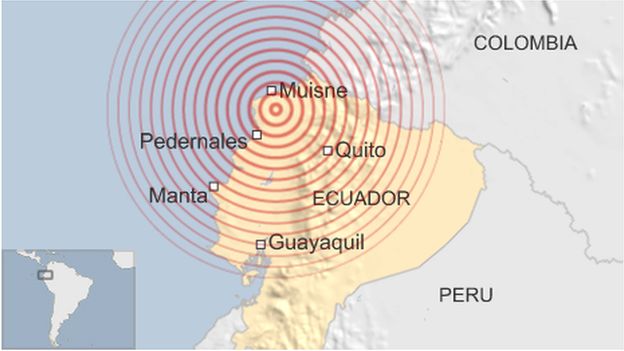

Following twin earthquakes in southern Japan, a 7.8-magnitude earthquake rattled Ecuador's central coast Saturday night, killing at least 233 people and injuring nearly 1,500. Dozens of people are still unaccounted for. Buildings collapsed, and power was knocked out for millions. The death toll is expected to rise as rescue workers comb through the damage.
A tsunami alert was issued, then lifted. Several provinces remain in a state of emergency, however, including Guayas, Manabi, Santo Domingo, Los Rios, Esmeraldas, and Galapagos.
The earthquake was centered 16.8 miles (27 kilometers) southeast of the coastal town of Muisne, according to the U.S. Geological Survey.
It was most likely the result of shallow thrust faulting on or near the boundary between the Nazca and Pacific plates. At that location, the Nazca Movement in this region has led to the uplift of the Andes and the largest earthquake on record, the 1960 magnitude 9.5 temblor in southern Chile.
This weekend's event was the deadliest to strike Ecuador since March 1987, when a 7.2-magnitude earthquake killed 1,000 people.


Saturday's quake caused a bridge and buildings to collapse in the country's largest city, Guayaquil, 300 miles (480 kilometers) away. No damage has been reported from the capital, Quito, 108 miles (173 kilometers) away. The shaking could be felt as far away as Colombia.

Some 10,000 troops and 3,500 police are being deployed in the affected areas, as rescue operations continue.
Coastal areas in the north-west were closest to the epicentre and officials say the death toll is rising.
Ecuador's President Rafael Correa has cut short a visit to Italy to deal with the crisis.
He has declared a state of emergency and said the priority is finding survivors.
"Everything can be rebuilt, but lives cannot be recovered, and that's what hurts the most," he said.
Ecuador's Vice-President Jorge Glas, visiting one of the worst-hit cities, Manta, met a resident who pleaded for people trapped under rubble.
"We cannot go in with heavy machinery because it can be tragic for the wounded," Mr Glas told him.
Helicopters and buses are ferrying troops north but have been hampered by landslides.
In some areas people are using their bare hands to try to dig out survivors.

Colombia announced it was sending rescue teams with search dogs, and its navy would carry water to the affected area.
Gabriel Alcivar, mayor of Pedernales, close to the epicentre, said the "entire town" had been flattened.
Ecuador is used to earthquakes. There have been seven magnitude-7.0 or greater events within 250km of this latest tremor since 1900. And some of these have resulted in very considerable loss of life, not just from the shaking but also from tsunami waves.
The country sits on the so-called "Ring of Fire" - the arc of high seismic activity that extends right around the Pacific basin. At its location, Ecuador fronts the boundary between the Nazca and South American tectonic plates.
These are vast slabs of the Earth's surface that grind past each other at a rate of about 65mm per year. The Nazca plate, which makes up the Pacific Ocean floor in this region, is being pulled down (subducted) and under the South American coast.
It is a process that has helped build the Andes and Ecuador's many volcanoes, including the mighty Chimborazo.
Mother earth is getting angrier as the planet warms up.
No comments:
Post a Comment
Through this ever open gate
None come too early
None too late
Thanks for dropping in ... the PICs